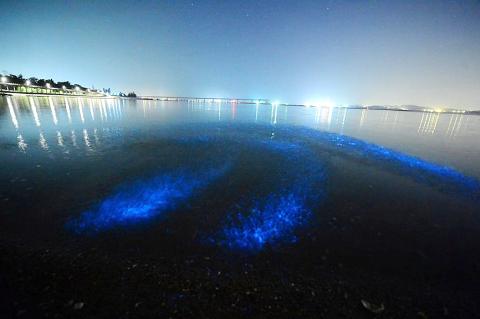Dubbed “blue tears” by local residents, bioluminescence along the shore of Kinmen in spring has become a major tourist attraction for the outlying county.
The natural phenomenon was first observed a long time ago, but has only become a popular tourist attraction since the county opened up its coastline to tourists in recent years, the Kinmen County Fisheries Research Institute said.
Blue tears are formed when clusters of bioluminescent marine algae are disturbed by waves, said Li Chia-fa (李家發), a lead researcher at the institute.

Photo: CNA, courtesy of the Kinmen Photographers’ Association
The phenomenon is prevalent in warm seawater in April and May.
In the past, blue tears were associated not with Kinmen, but the Matsu Islands of Lienchiang County, which was thought to be the only location in Taiwan where it occurred, the institute said.
Hsu Chin-hsi (許進西), who heads the Kinmen Photographers’ Association, said that Kinmen’s topography makes it easier for visitors to get up close to the natural phenomenon.
People can even hold the glowing algae in their hands, whereas in Matsu it can only be viewed in the distance from a beach, Hsu said.
Blue tears can only be seen clearly in near-pitch darkness. Even the moon affects visibility, the association said.
The research institute plans to introduce an ecological tour based on the phenomenon to educate the public about environmental protection and conservation, while addressing such issues as marine pollution, Li said.
People wanting to see blue tears can also visit a pond in Jiougang Borough (舊港) in Kaohsiung’s Mituo District (彌陀), where they have been seen.
News that sparkles were sighted in a pond in the borough was reported last year, but the site is hard to find and the terrain is difficult to traverse, leading to many instances of visitors falling into ditches or becoming lost, residents said.
Groups are visiting the area as news of the phenomenon spreads, residents said.
Jiougang Police Chief Ou Chien-ming (毆建銘) said that the police station has set up an area to provide instructions on how to get to the pond, as many people go there to ask for directions.
The station urged visitors to refrain from driving on the narrow paths near the pond and to drive slowly at night.
People should not get too close to the edge of the pond, as they might fall in, and should refrain from feeding fish in the pond, as it could harm the pond’s ecology, the station said.

US climber Alex Honnold is to attempt to scale Taipei 101 without a rope and harness in a live Netflix special on Jan. 24, the streaming platform announced on Wednesday. Accounting for the time difference, the two-hour broadcast of Honnold’s climb, called Skyscraper Live, is to air on Jan. 23 in the US, Netflix said in a statement. Honnold, 40, was the first person ever to free solo climb the 900m El Capitan rock formation in Yosemite National Park — a feat that was recorded and later made into the 2018 documentary film Free Solo. Netflix previewed Skyscraper Live in October, after videos

Starting on Jan. 1, YouBike riders must have insurance to use the service, and a six-month trial of NT$5 coupons under certain conditions would be implemented to balance bike shortages, a joint statement from transportation departments across Taipei, New Taipei City and Taoyuan announced yesterday. The rental bike system operator said that coupons would be offered to riders to rent bikes from full stations, for riders who take out an electric-assisted bike from a full station, and for riders who return a bike to an empty station. All riders with YouBike accounts are automatically eligible for the program, and each membership account

A classified Pentagon-produced, multiyear assessment — the Overmatch brief — highlighted unreported Chinese capabilities to destroy US military assets and identified US supply chain choke points, painting a disturbing picture of waning US military might, a New York Times editorial published on Monday said. US Secretary of Defense Pete Hegseth’s comments in November last year that “we lose every time” in Pentagon-conducted war games pitting the US against China further highlighted the uncertainty about the US’ capability to intervene in the event of a Chinese invasion of Taiwan. “It shows the Pentagon’s overreliance on expensive, vulnerable weapons as adversaries field cheap, technologically

NUMBERs IMBALANCE: More than 4 million Taiwanese have visited China this year, while only about half a million Chinese have visited here Beijing has yet to respond to Taiwan’s requests for negotiation over matters related to the recovery of cross-strait tourism, the Tourism Administration said yesterday. Taiwan’s tourism authority issued the statement after Chinese-language daily the China Times reported yesterday that the government’s policy of banning group tours to China does not stop Taiwanese from visiting the country. As of October, more than 4.2 million had traveled to China this year, exceeding last year. Beijing estimated the number of Taiwanese tourists in China could reach 4.5 million this year. By contrast, only 500,000 Chinese tourists are expected in Taiwan, the report said. The report